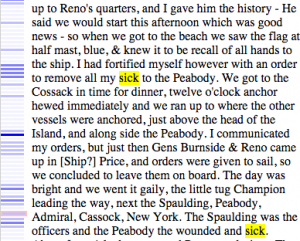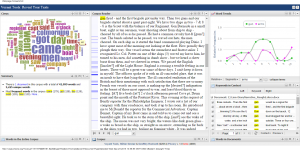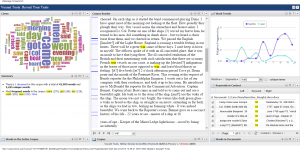For our final project, Mary Medure and I collaborated together to compare and contrast James Merrill Linn’s diary entries and his letters to his mother and brother, John. We wanted to focus more on the content of his diary entries and letters rather than specific tools that documented his locations. Thus, instead of mapping, we chose to each transcribe different letters that would be eventually tagged in TEI and converted to a Digital Edition. Mary and I chose to transcribe letters that were written around the same time frame to compare the content in each letter. Additionally, we wanted to transcribe both the letters that were in the same time frame as the diary entries we transcribed earlier this semester. Mary transcribed the letter to John on February 11, 1862 and her diary entries she already transcribed were February 8-12, 1862. I transcribed the letter to Linn’s mother on February 19, 1862 and the diary entries from February 5-7, 1862. We used Voyant tools to compare his most commonly used words in his diary entries and letters.

During the transcription process, Mary and I separately transcribed the 2 pages of each letter and then collaborated together to clarify the words we could not decipher. We would read the letters aloud to each other to make more sense of Linn’s experiences. However, some words were illegible so we went to the archives in the library to read the letters first hand. In Linn’s letter to his Mother, Mary and I could not read the words at the end of each page because of the binding of the documents. In the archives, we could not bend or fold the pages over to read the full words so we had to make some educated guesses related to the context of each sentence. In Pierazzo’s article, she raises a great point that “[j]udgment is necessarily involved in deciding what is in fact present [in the manuscript], as when an ambiguously formed character resembles two different letters; but the transcriber’s goal is to make an informed decision about what is actually inscribed at each point (Meulen and Tanselle, 1999, p. 201)” (465). This demonstrates that although Mary and I went to the archives for a second look at the documents, we still needed to make educated contextual guesses for multiple words for the document to make sense. For example, the screenshot on the left shows the word “tomatoes” cut off. In this section of the letter, he was talking about food and “toma-” is legible. Therefore, I needed to make an educated guess with regards to the context of the sentence to figure out the word that was cut off at the end of the page.

After the transcription process, we needed to start tagging the words that we felt were most important to include. To make the tagging process simpler, we color coded based on person/people, place, affiliation, object, state, trait, event, date, time and military role. In our diary entries, we did not color code to the same extent. We found that affiliation and person/people were important enough to be a separate entity. For instance, we consider “Americans” to be an affiliation because it is a group of people associated to a specific location. We also categorized “war” and “battles” as events rather than places because they are at different locations. I did not have “event” as a category in the diary entry I transcribed because he would refer to the battles as their real names. As he writes to his mother, I believe that he refers to the battles generally because he is not using the letters as a reference to his specific locations and events.

After color coding, we noticed that the majority of words we highlighted were descriptions and states of well being. Highlighted in turquoise are the descriptions and highlighted in gray are states, including weather and emotions. He is writing to his mother pertaining more of his personal experiences and his emotional responses to the war overall. After color coding the letters, we tagged the words that were highlighted and transferred the document to Oxygen to make a Digital Edition.

Voyant is a great tool to use when comparing contextual information in different documents. Therefore, Mary and I thought it would be a good idea to compare the diary entries to the letters using Voyant. First, we took our my transcription files of Linn’s letter to his mother and brother, John, to show the most commonly used words. I noticed that he frequently used “hope”, “remember”, “little”, and “home”. These words are more of an expression and description of how he feels and his reactions to his surroundings as opposed to specific locations and people. He refers to “home” (Lewisburg) frequently, which makes sense because he is talking to his mother. Generic terms like “men” and “company” are commonly used because his letter to his mother is more of a representation of his personal experiences rather than a collection of locations he travels to or people he encounters.

After analyzing our transcriptions of Linn’s letters to his mother and brother, Mary and I combined our diary entries to see the most commonly used words. We noticed that military men of different ranks were prevalent throughout his diary entries. Linn refers to specific people such as General Burnside, Captain Bennet, and many more. Comparatively speaking, “battle” appears to be used in both the letters and diary entries; however, “battle” is significantly larger, indicating it was used more, in his diaries. This supports the hypothesis that Linn’s diary entries are more of a personal account of places and people, whereas his letters to his family are more of his emotional experiences throughout the war.
Transcribing Linn’s letters to his mother and John around the same time as Linn’s previously transcribed diary entries gave Mary and I the support to claim that Linn’s diary entries are a personal collection for himself of locations he has traveled to and people he has encountered along the way. In contrast, Linn’s letters to his mother and John are more generic and express his feelings regarding the war rather than the a series of places and people. Color coding helped us significantly as we found that our hypothesis was correct in saying that Linn’s writing to his mother and brother were more emotional and personal whereas his diary entries were a collection of people and places for himself to remember later. To visualize the contrast in diary entries and letters written to family, Voyant is a great visualization tool to give the viewer a general idea of the premise and themes of each document. Overall, this project gave me a much better understanding of James Merrill Linn’s diary purpose in writing what he did in both his diary entries and letters to home.
Here are the links to my final TEI product!
Digital edition: http://www.students.bucknell.edu/projects/HUMN10002/Harmatz/content/Harmatz_final.xml

 e another. The first thing I noticed was how extreme the frequencies were, they never really remained flat for a long period of time. The result of comparing them was also not what I expected. In segments 1, 2, 3, and 4 the two words did not have even slightly similar word trends, they were complete opposites. However, in segments 5, 7, 8 and 9 they had either identical word trends or very similar ones, as shown below. And although this somewhat supports my hypothesis, it does not completely.
e another. The first thing I noticed was how extreme the frequencies were, they never really remained flat for a long period of time. The result of comparing them was also not what I expected. In segments 1, 2, 3, and 4 the two words did not have even slightly similar word trends, they were complete opposites. However, in segments 5, 7, 8 and 9 they had either identical word trends or very similar ones, as shown below. And although this somewhat supports my hypothesis, it does not completely. diary entry, “sick” was used 4 times, and in the one right after it was used 5 times. “Cossack” is used, as I expected, most often when they are aboard the ship, but also when they are about to go on it or right after they got off the boat. The word frequencies overlap especially in segments 5 and 8 because that is when the men in the army and their prisoners were getting very sick aboard the ship.
diary entry, “sick” was used 4 times, and in the one right after it was used 5 times. “Cossack” is used, as I expected, most often when they are aboard the ship, but also when they are about to go on it or right after they got off the boat. The word frequencies overlap especially in segments 5 and 8 because that is when the men in the army and their prisoners were getting very sick aboard the ship.


